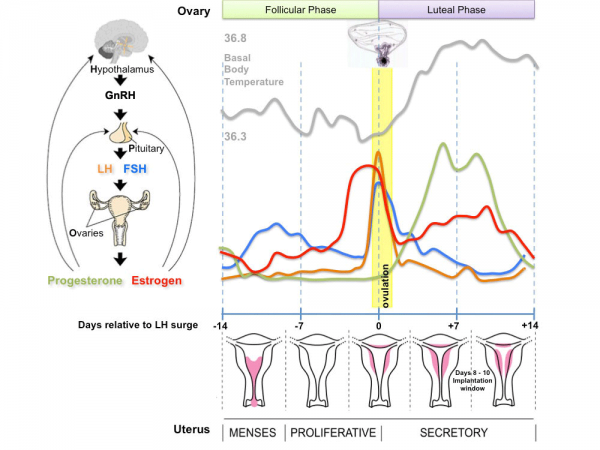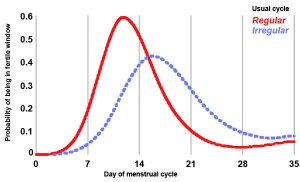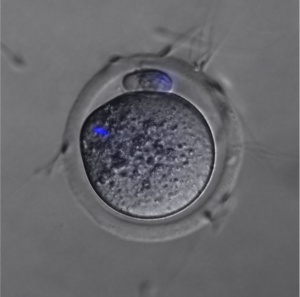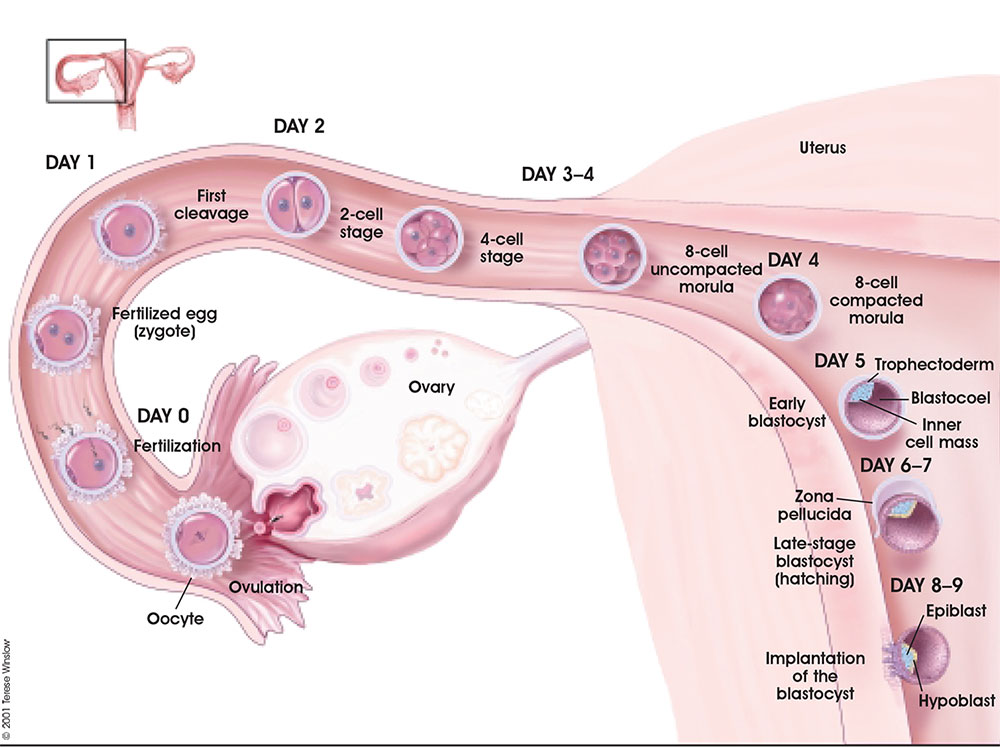Foundations Practical - Week 1 and 2
Fertilization and Blastocyst Development
- The menstrual cycle dictates timing of fertilization and implantation and therefore when life can begin.
Development starts before fertilization with the release of the egg from the ovary (ovulation). This process along with preparation of the uterus for implantation is an endocrine controlled cycle, the menstrual cycle.
This first page will give a brief overview of: menstrual cycle, fertilization, blastocyst and implantation. You are not expected to know everything about these processes, just keep track of the relative "timings" as to when specific processes occur.
Ovulation
<wikiflv width="368" height="320" autoplay="false">Follicle_001.flv|File:Follicle 001 icon.jpg</wikiflv>
Links: Development Animation - Ovulation | Movie - Ovulation 01
Menstrual Facts
- The average menstrual cycle is 28 days with ovulation (egg release) occuring approximately the middle of the cycle.
- The last menstrual period is used clinically in determining developmental ages. (More Birth Date)
- Menstruation phase (period) is the loss of the uterus epithelial functional layer and occurs if fertilization and implantation has not occurred before the end of the current cycle.
Fertility Window
Clinical guidelines have typically identified the "fertile window" between days 10 and 17 within the typical 28 day menstrual cycle.
Data from a large USA NIEHS - Early Pregnancy Study (1982-86) identified the timing of the “fertile window” within a range of different menstrual cycles.[1]
- fertile window occurred during a broad range of days in the menstrual cycle.
- between days 6 and 21 women had at minimum a 10% probability of being in their fertile window.
- women cannot predict a sporadic late ovulation; 4 - 6% of women whose cycles had not yet resumed were potentially fertile in the fifth week of their cycle.
- only about 30% of women is the fertile window entirely within the days of the menstrual cycle identified by clinical guidelines (between days 10 and 17)
- most women reach their fertile window earlier and others much later.
- women should be advised that the timing of their fertile window can be highly unpredictable, even if their cycles are usually regular.
Fertilization
Week 1 and 2
Week 1 Movies
| Ovulation | Fertilization | Pronuclear Fusion | Week 1 | Ovulation in the rabbit | Fertilization in the mouse | Blastocyst Development |
Pregnancy Test
Due Date Calculator
Gamete Formation
Oogenesis and Spermatogenesis are the processes of haploid gamete formation by meiosis. If you have some time in the Lab also have a look at these topics and the gonad structure.
Terms
- blastocyst - (Greek, blastos = sprout + cystos = cavity) Term used to describe the hollow cellular mass taht forms in early development. In humans, this stage occurs in the first and second weeks after the zygote forms a solid cellular mass (morula stage) and before implantation. The blastocyst consists of cells forming an outer trophoblast layer, an inner cell mass (embryoblast) and a fluid-filled cavity. The blastocyst inner cell mass is the source of true embryonic stem cells capable of forming all cell types within the embryo.
- conceptus - The entire product of conception, that is all the structures derived from the zygote and includes not only the embryo, but also the placental and membrane components.
- gonad - (Greek, gonos = seed) A gamete-producing (germ cell) organ. A non-sexual term which is used to describe both the female ovary and male testis.
- hCG - An acronym for the hormone human Chorionic Gonadotrophin.
- human Chorionic Gonadotrophin - (hCG) Placental hormone initially secreted by cells (syncitiotrophoblasts) from the implanting conceptus during week two, supporting the ovarian corpus luteum, which in turn supports the endometrial lining and therefore maintains pregnancy. Hormone can be detected in maternal blood and urine and is the basis of many pregnancy tests. Hormone also stimulates the onset of fetal gonadal steroidogenesis, high levels are teratogenic to fetal gonadal tissues.
- implantation - The term used to describe process of attachment and invasion of the uterus endometrium by the blastocyst (conceptus). Abnormal implantation is where this process does not occur in the body of the uterus (ectopic) or where the placenta forms incorrectly.
- uterus - The female internal genital (reproductive) tract forming a hollow muscular walled organ, embryonically derived from the paramesonephric ducts. The human uterus has two uterine tubes or horns (fallopian tubes) where the first week of development occurs and a single hollow body where implantation of the blastocyst normally occurs. Following puberty, the non-pregnant uterus (epithelium and underlying stroma) undergoes cyclic changes under the influence of hormones, the menstrual cycle. This cycle of uterine changes ceases during pregnancy and it contributes the maternal component of the placenta.
Foundations Practical: Introduction | Week 1 and 2 | Week 3 and 4 | Week 1 to 8 | Week 9 to 36 | Neonatal | Critical Periods | Additional Resources | Quiz
Glossary: A | B | C | D | E | F | G | H | I | J | K | L | M | N | O | P | Q | R | S | T | U | V | W | X | Y | Z | Numbers
Cite this page: Hill, M.A. (2024, April 16) Embryology Foundations Practical - Week 1 and 2. Retrieved from https://embryology.med.unsw.edu.au/embryology/index.php/Foundations_Practical_-_Week_1_and_2
- © Dr Mark Hill 2024, UNSW Embryology ISBN: 978 0 7334 2609 4 - UNSW CRICOS Provider Code No. 00098G






